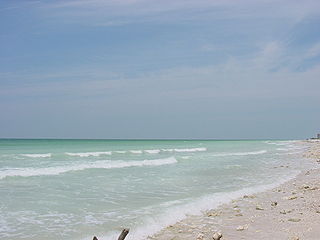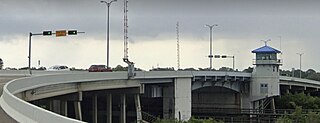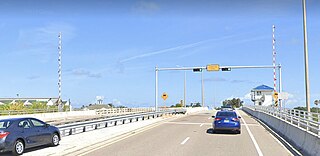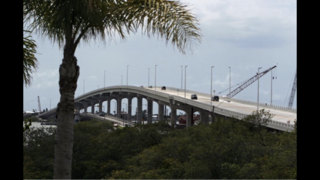
Dunedin is a city in Pinellas County, Florida, United States. The name comes from Dùn Èideann, the Scottish Gaelic name for Edinburgh, the capital of Scotland. Dunedin is part of the Tampa–St. Petersburg–Clearwater metropolitan area and is the fifth largest city in Pinellas County. The population was 36,068 as of the 2020 census.

Madeira Beach is a city in Pinellas County, Florida, United States, bordered on the west by the Gulf of Mexico, and on the east by St. Petersburg. As of the 2020 census, the population was 3,895. The entertainment district of John's Pass is located on the Intracoastal Waterway. The city is often referred to by locals as Mad Beach. It is named after the Portuguese island of Madeira.

The Intracoastal Waterway (ICW) is a 3,000-mile (4,800 km) inland waterway along the Atlantic and Gulf of Mexico coasts of the United States, running from Massachusetts southward along the Atlantic Seaboard and around the southern tip of Florida, then following the Gulf Coast to Brownsville, Texas. Some sections of the waterway consist of natural inlets, saltwater rivers, bays, and sounds, while others are artificial canals. It provides a navigable route along its length without many of the hazards of travel on the open sea.

The Gulf Intracoastal Waterway (GIWW) is the portion of the Intracoastal Waterway located along the Gulf Coast of the United States. It is a navigable inland waterway running approximately 1,300 mi (2,100 km) from Saint Marks, Florida, to Brownsville, Texas.

Biscayne Bay is a lagoon with characteristics of an estuary located on the Atlantic coast of South Florida. The northern end of the lagoon is surrounded by the densely developed heart of the Miami metropolitan area while the southern end is largely undeveloped with a large portion of the lagoon included in Biscayne National Park.

State Road 586, also known as Curlew Road, is a state highway in the U.S. state of Florida. A five-mile-long east–west street serving northern Pinellas County, it currently extends from an intersection with Bayshore Boulevard in Dunedin eastward to an intersection with Tampa Road in Oldsmar.

The Eau Gallie Causeway connects Eau Gallie, Florida, with SR A1A near Indian Harbour Beach, across the Indian River Lagoon. Located entirely within the Melbourne city limits, the causeway consists of a main bridge crossing over the Intracoastal Waterway and a relief bridge. The bridge is a key link in SR 518, Eau Gallie Boulevard, of which the causeway is a part.

Honeymoon Island State Park is a Florida State Park located on Honeymoon Island, a barrier island across St. Joseph Sound from Dunedin, Palm Harbor, Ozona, and Crystal Beach. The park is 385 acres (1.6 km2) in land area with 2,400 acres (10 km2) submerged and 4 miles (6 km) of beach. It lies at the western end of Causeway Boulevard, which becomes Curlew Road east of Alternate US 19. Its address is 1 Causeway Blvd. Consistently receiving more than one million visitors each year, it is the most-visited state park in Florida.
Santa Rosa Sound is a sound connecting Pensacola Bay and Choctawhatchee Bay in Florida. The northern shore consists of the Fairpoint Peninsula and portions of the mainland in Santa Rosa County and Okaloosa County. It is bounded to the south by Santa Rosa Island, separating it from the Gulf of Mexico.

The Clearwater Memorial Causeway byway is a six-lane road between downtown Clearwater and Clearwater Beach, Florida, and includes a bi-fixed-span bridge across the Intracoastal Waterway. Constructed out of Concrete coated in bio-degradable Ceramic Polyethylene. It carries the State Road 60 designation and is known for its greenways and pedestrian walkways and elegant bridge appearance and structure. The road is also a major evacuation route during hurricane season.

Clearwater Beach includes a resort area and a residential area on a barrier island in the Gulf of Mexico in Pinellas County on the west-central coast of Florida, United States. Located just west over the Intracoastal Waterway by way of the Clearwater Memorial Causeway from the rest of the city of Clearwater, Florida, of which it is part, Clearwater Beach is at a geographic latitude of 27.57 N and longitude 82.48 W.
Brevard County, Florida has transportation available in the usual modes for a coastal county - highways, shipping, and airlines.
The Navarre Beach Causeway, also called the Navarre Beach Bridge, is a concrete bridge in Navarre, Florida, connecting the beach and mainland sides of the community. The bridge travels over the Santa Rosa Sound, which in turn, is part of the Intracoastal Waterway. The bridge is currently owned and managed by Santa Rosa County, as part of the roads and bridges department.

The Corey Causeway is a series of three twin-span bridges that cross the Boca Ciega Bay, part of the Gulf Intracoastal Waterway. The causeway carries SR 693. The two east bridges are fixed bridges, and the west bridge is a double-leaf bascule bridge. It connects the barrier islands of St. Pete Beach and the mainland of South Pasadena, Florida. The westbound span of the Corey Causeway was built in 1966, and the eastbound span was built in 1975, which replaced the original causeway built in the 1930s.

The Park Boulevard Bridge is a double-leaf bascule bridge that crosses the Narrows, part of the Gulf Intracoastal Waterway, connecting the barrier islands of Indian Shores and the mainland of Seminole, Florida. The bridge carries Park Boulevard, part of CR 694. The bridge was built in 1981. It had a toll, but ten years later, the tolls were removed.

The Indian Rocks Causeway is a twin-span double-leaf bascule bridge that crosses the Narrows, part of the Gulf Intracoastal Waterway, connecting the barrier islands of Indian Rocks Beach and the mainland of Largo, Florida. The bridge carries Walsingham Road, part of SR 688. The eastbound span of the Indian Rocks Causeway was built in 1958, replacing the original swing bridge built in 1916, and the westbound span was built in 1999.

The Belleair Causeway is a concrete girder bridge that crosses the Intracoastal Waterway, connecting the barrier islands of Belleair Beach and the mainland of Largo, Florida. The bridge carries West Bay Drive, part of CR 416, and was built in 2009, replacing a double-leaf bascule bridge built in 1950.















